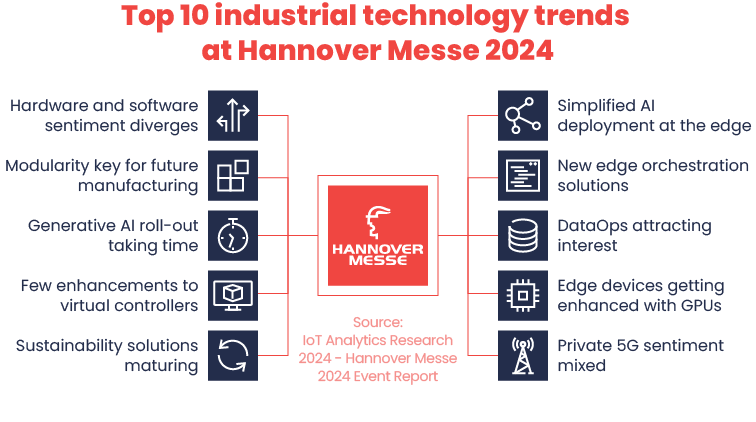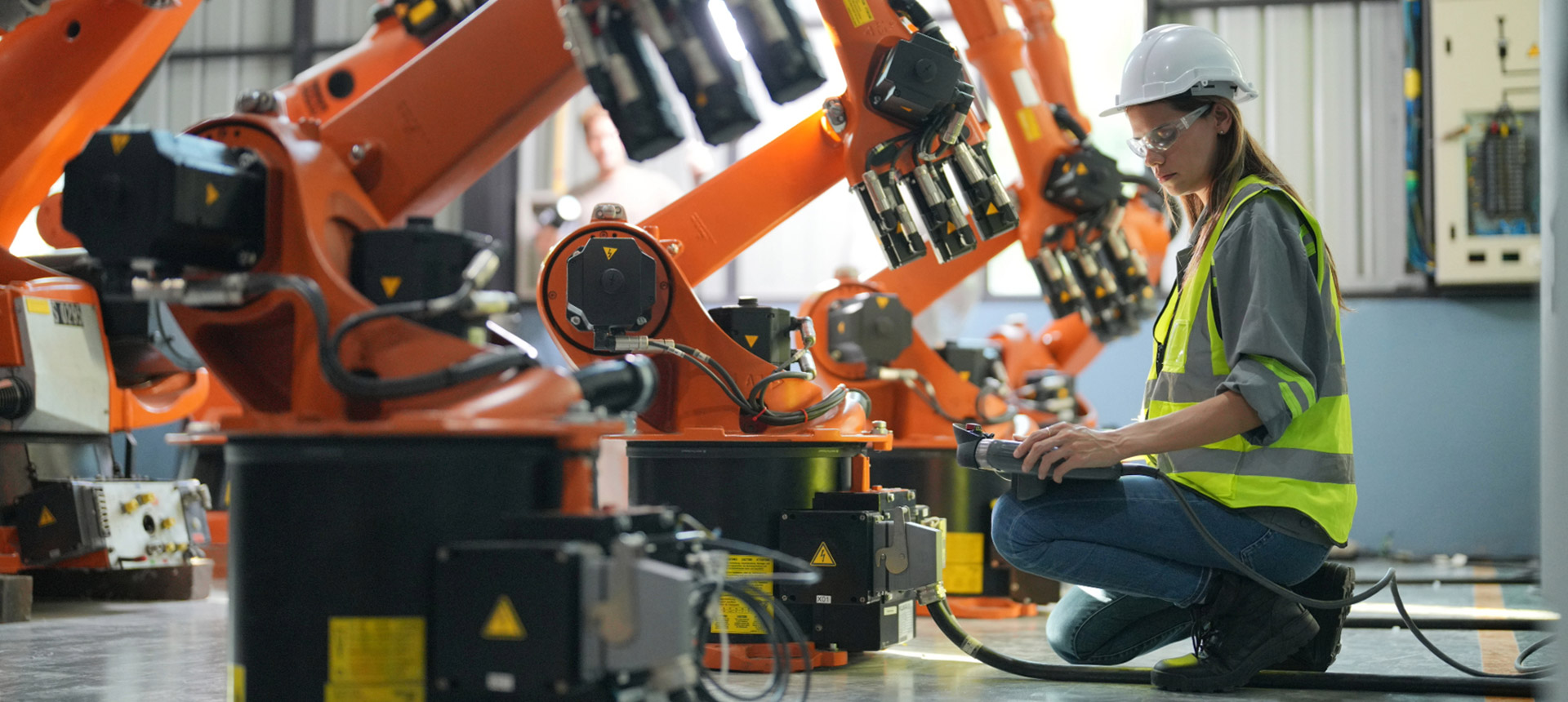Key takeaways:
- Solutions not technologies – exhibitors at major IoT trade shows such as Hannover Messe 2024 emphasize showcasing technology as part of particular solutions rather than standalone technologies.
- Artificial Intelligence and GenAI in IoT are not yet as prominent as expected; however, forecasts for 2025 and beyond are promising.
- With the growth of IoT devices and data generated by IoT products, DataOps is becoming one of the key areas in enterprise IoT.
- 1. What are the top IoT trends in 2024?
- 2. What are the top IoT trends in 2024?
- 3. Combining IoT and AI
- 4. Trends in IoT analytics: DataOps
- 5. What are the emerging trends in IoT security?
- 6. What role does automation play in IoT trends?
- 7. What are the key insights into IoT connectivity?
- 8. Summary
What are the top IoT trends in 2024?
According to McKinsey, the estimated economic value of IoT could reach $12 trillion globally by 2030, highlighting the vast potential within the IoT landscape. The rapid adoption of connected devices is revolutionizing industries, providing numerous benefits of IoT, such as enhanced efficiency, improved service management, and real-time data analytics.
There is no room for theorizing here. Leaders in industries (IoT in the healthcare, manufacturing, and energy sectors, just to mention a few) rely on practical solutions and concrete showcases. So we can observe the rise in importance of agile data management and demand for solutions that increase corporate efficiency, relieve the burden on employees, improve supply chain management, and allow for fast maintenance services (e.g., through intelligent automation). Below we have collected what we believe are the most important of the latest trends in IoT.

How will AI technology influence the future of IoT?
2023 marked an acceleration in industrial Artificial Intelligence solutions. Recent IoT Analytics surveys indicate that Artificial Intelligence can become a top 5 technology priority in 2025. Expectations for Artificial Intelligence in Internet of Things solutions are high, with forecasts that by 2027 nearly 50% of IoT solutions will have an Artificial Intelligence component.
Combining IoT and AI
One challenge is the rollout time, which many vendors aim to address by offering capabilities that facilitate Artificial Intelligence deployment on edge devices. Companies today are more interested in solutions, not technologies – this trend was especially emphasized at the largest industry conference, Hannover Messe 2024. Showcasing particular Artificial Intelligence applications in specific industry solutions certainly needs time, and that’s why, despite the high hopes for AI, it is not yet shining as brightly as had been expected. In terms of IoT solutions, Artificial Intelligence deployment features the highest level of IoT maturity, which many companies are not yet prepared for.
Download the e-book to learn more: IoT Maturity Levels – from Digitization to Autonomy
Trends in IoT analytics: DataOps
In terms of IoT data, according to IDC, IoT devices are to generate nearly 80 zettabytes by 2025. With such vast amounts of data generated by IoT devices, companies need more efficient data governance methods.
One of the latest trends is DataOps (Data Operations), which is an agile approach to data delivery and management similar to DevOps. It aims to make the process of data governance and data product management as fluent as the software development product lifecycle.

This is also applicable to data from IoT devices. DataOps addresses the needs of organizations that adopt Industry 4.0 and smart manufacturing solutions based on data contextualization. Putting data in context takes place as early as the data understanding level. Once the data are understood, companies can start analyzing them, which brings even more value and insights.
What are the emerging trends in IoT security?
IoT Analytics forecasts for 2027 indicate that the number of connected IoT devices may reach 30 trillion. The upward trend is steady. IoT is an organism in which every element matters. The challenge is to secure critical machinery equipment, secure data, and provide network access. In addition, minimizing human factor risks and errors through training and cybersecurity awareness is also a challenge.

The more IoT devices, the bigger the role of solutions allowing for the prevention of attacks on IoT such as “Security by Default” (to save additional work and configuration), the Zero Trust approach (to protect access to the network), and “Privacy by Design” (to safeguard sensitive data).
Security is not just about technology. Through proper practices such as micro-segmentation, network access control, secure gateway management, and staff training, companies can counteract malicious attacks.
What role does automation play in IoT trends?
Automation is considered to be a high level of IoT maturity deployment and one of the biggest trends of the day. At this level, it is not only important to monitor the devices, but also to take control for additional value. Just imagine that centralized solutions can control thousands of devices dispersed all over the world. This type of solution is already used, for example, by the energy sector, wherein energy providers automate maintenance work on wind farms.
Another layer of automation at this level is built on top of Machine Learning algorithms. Building and training the models for Machine Learning is quite an extensive task, but once the model is put into the repository, it is possible to build automated pipelines. It is also necessary to build additional business logic components into a solution that manages commands and makes it possible (for example, with Machine Learning models or any enterprise applications via API) to send commands to devices.
Also read: Predictive maintenance
What are the key insights into IoT connectivity?
The IoT connectivity level is the backbone of IoT infrastructure. Among wired and wireless technologies, one of the strongest trends for years now has been 5G connectivity. Mobile solutions meet the needs of covering large areas, low power consumption, and fast data transfer, so interest in cellular IoT applications is consistently strong.
Managed 5G services are having their moment in the sun now, as private 5G still comes with many challenges: deployment costs, network maintenance complexities, and an immature ecosystem lacking essential hardware.
 Want to learn more about the Internet of Things? Read our whitepaper and learn how to successfully implement, manage and develop IoT solutions!Read now! |
Trends on the Internet of Things for 2024 and beyond – summary
As the IoT market size continues to expand, the integration of AI and IoT will play a crucial role in enhancing IoT capabilities. We can observe the rise of DataOps practices as companies need to manage vast amounts of data and derive actionable insights for smarter decision-making.
Connectivity solutions still play an important role in the current IoT landscape, with managed 5G at the forefront of wireless trends.
The security of devices, networks, and amounts of data that IoT devices generate is also a challenge; hence, cybersecurity solutions are more than a trend, but a must-have.
Looking forward, the convergence of the above trends will not only redefine existing applications but also pave the way for innovations that address the most complex challenges. The year 2024 witnessed transformative trends in the IoT ecosystem, as organizations increasingly leverage IoT applications. The state of IoT is evolving rapidly, with innovative smart devices becoming more interconnected, which in turn enables users to unlock the full potential of IoT.
- 1. What are the top IoT trends in 2024?
- 2. What are the top IoT trends in 2024?
- 3. Combining IoT and AI
- 4. Trends in IoT analytics: DataOps
- 5. What are the emerging trends in IoT security?
- 6. What role does automation play in IoT trends?
- 7. What are the key insights into IoT connectivity?
- 8. Summary
